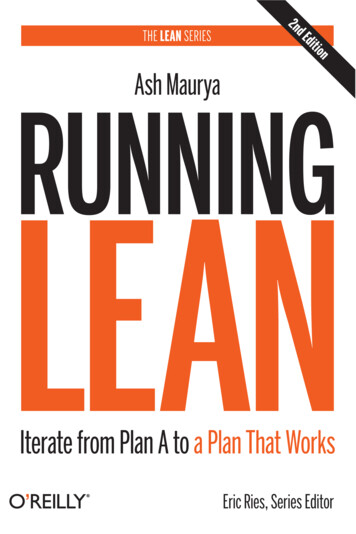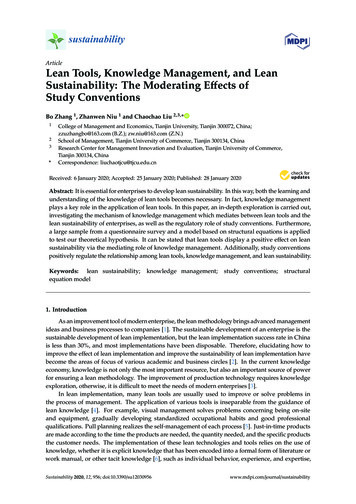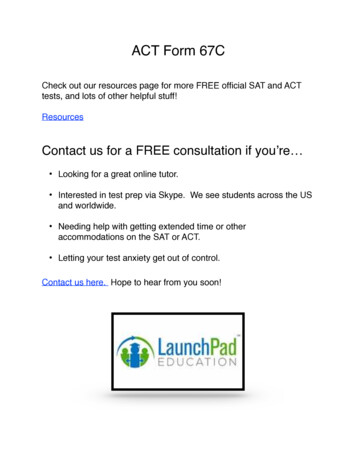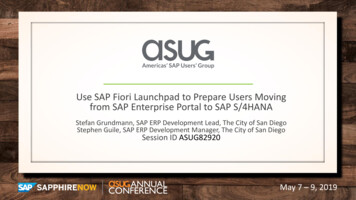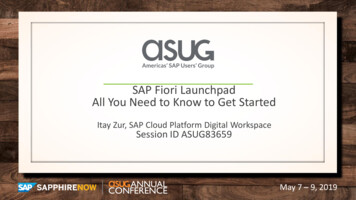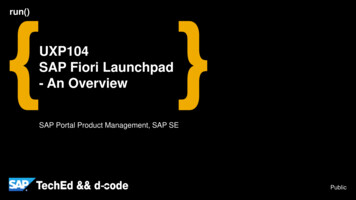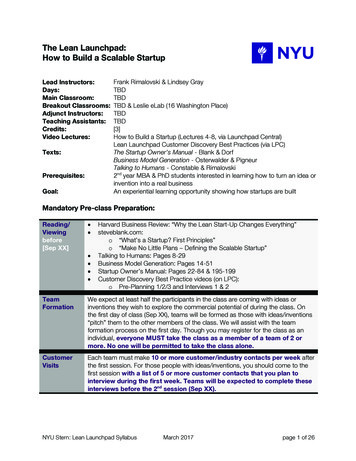
Transcription
The Lean Launchpad:How to Build a Scalable StartupLead Instructors:Days:Main Classroom:Breakout Classrooms:Adjunct Instructors:Teaching Assistants:Credits:Video Lectures:Texts:Prerequisites:Goal:Frank Rimalovski & Lindsey GrayTBDTBDTBD & Leslie eLab (16 Washington Place)TBDTBD[3]How to Build a Startup (Lectures 4-8, via Launchpad Central)Lean Launchpad Customer Discovery Best Practices (via LPC)The Startup Owner’s Manual - Blank & DorfBusiness Model Generation - Osterwalder & PigneurTalking to Humans - Constable & Rimalovski2nd year MBA & PhD students interested in learning how to turn an idea orinvention into a real businessAn experiential learning opportunity showing how startups are builtMandatory Pre-class Preparation:Reading/Viewingbefore[Sep XX] Harvard Business Review: “Why the Lean Start-Up Changes Everything”steveblank.com:o “What’s a Startup? First Principles”o “Make No Little Plans – Defining the Scalable Startup”Talking to Humans: Pages 8-29Business Model Generation: Pages 14-51Startup Owner’s Manual: Pages 22-84 & 195-199Customer Discovery Best Practice videos (on LPC):o Pre-Planning 1/2/3 and Interviews 1 & 2TeamFormationWe expect at least half the participants in the class are coming with ideas orinventions they wish to explore the commercial potential of during the class. Onthe first day of class (Sep XX), teams will be formed as those with ideas/inventions“pitch” them to the other members of the class. We will assist with the teamformation process on the first day. Though you may register for the class as anindividual, everyone MUST take the class as a member of a team of 2 ormore. No one will be permitted to take the class alone.CustomerVisitsEach team must make 10 or more customer/industry contacts per week afterthe first session. For those people with ideas/inventions, you should come to thefirst session with a list of 5 or more customer contacts that you plan tointerview during the first week. Teams will be expected to complete theseinterviews before the 2nd session (Sep XX).NYU Stern: Lean Launchpad SyllabusMarch 2017page 1 of 26
Section I: Course Overview & The Lean Startup MethodologyThis course provides real world, hands-on learning on what it’s like to actually start a high-technew venture. This class is not about how to write a business plan. It’s not an exercise on howsmart you are in a classroom, or how well you use the research library to size markets. And theend result is not a PowerPoint slide deck for a VC presentation. And it is most definitely not anaccelerator to build the “hot-idea” you have in mind.This is a practical class—essentially a lab, not a theory or “book” class. Our goal, within theconstraints of a classroom and a limited amount of time, is to create an entrepreneurial experiencefor students with all the pressures and demands of the real world in an early stage startup.Students will be getting their hands dirty talking to customers, partners and competitors, as theyencounter the chaos and uncertainty of how a startup actually works. You will be expected toconduct at least 100 customer/partner interviews during the class ( 10 per week). Eachweek will be a new adventure outside the classroom as you test each part of your business modeland then share the hard earned knowledge with the other teams and instructors.You’ll work in teams learning how to turn a great idea or invention into a great business. You’lllearn how to use a business model to brainstorm each part of a company and customerdevelopment to get out of the classroom to see whether anyone other than you would want/useyour product or service. Finally, based on the feedback gathered, you will use agile development torapidly iterate your product to build something your customers would use and buy.Team Organization & Suggested ProjectsThis class is team-based. No one will be permitted to take the class alone. Working, studying andcustomer discovery interviews will be done in teams. No exceptions will be made.Team projects can be for consumers or enterprises; software, web/mobile, physical products, orservices of any kind. While your first instinct may be a web/mobile startup, we suggest that youconsider something you are a domain expert, such as your research if applicable. In all cases, youshould choose something for which you have passion, enthusiasm, and hopefully some expertise.Every student is encouraged to come to the first day of class with an idea, invention or conceptthey wish to explore the commercial potential of during the class. On the first day of class, teamswill be formed as those with ideas/inventions “pitch” them to the other members of the class. Wewill assist with the team formation process on the first day. More on this later.Once formed, teams will self-organize and establish individual roles on their own. There are noformal CEO/VP’s – just the constant parsing and allocating of the tasks that need to be done.The Lean StartupSteve Blank’s HBR article in titled Why The Lean Start-Up Changes Everything begins:“Launching a new enterprise—whether it’s a tech startup, a small business, or an initiativewithin a large corporation—has always been a hit‐or‐miss proposition. According to thedecades‐old formula, you write a business plan, pitch it to investors, assemble a team,NYU Stern: Lean Launchpad SyllabusMarch 2017page 2 of 26
introduce a product, and start selling as hard as you can. And somewhere in this sequence ofevents, you’ll probably suffer a fatal setback. The odds are not with you: As new research byHarvard Business School’s Shikhar Ghosh shows, 75% of all startups fail.But recently an important countervailing force has emerged, one that can make the process ofstarting a company less risky. It’s a methodology called the “lean startup,” and it favorsexperimentation over elaborate planning, customer feedback over intuition, and iterative designover traditional “big design up front” development. Although the methodology is just a fewyears old, its concepts—such as “minimum viable product” and “pivoting”—have quickly takenroot in the startup world, and business schools have already begun adapting their curricula toteach them.”Historically, we assumed startups were simply smaller versions of large companies, and wetherefore believed that the strategy we should employ to build and run a startup should follow bestpractices for running large companies. What Steve and others have realized, however, is that infact startups are not like big companies, and therefore we need different processes for buildingand growing them.We now define a startup as a temporary organization designed to search for a repeatableand scalable business model. The emphasis on the search for a business model versusexecution of a plan is the heart of the Lean Startup methodology.This class will heavily leverage the Lean Startup methodology, pushing teams to literally get out ofthe building and talk to customers and quickly iterate and pivot based on the insights gleaned.Steve Blank and others have developed a curriculum called the Lean LaunchPad to help guideentrepreneurs through the Lean Startup process. It has been tested and proven at top universitieslike Stanford, UC‐Berkeley, Columbia and many others, and through government‐funded programslike the NSF’s I‐Corps, among others. The syllabus for this class is based on the Lean LaunchPadcurriculum with some changes to adapt it to our specific circumstances.What you will and will not be taught:The class experience focuses on the process of clearly formulating the business aspects of astartup vision and validating it. Initially, all you will have is a vision for a startup, your startup vision.You will learn to use the Business Model Canvas (BMC) as a tool to succinctly represent the keybusiness components of your startup vision, such as, who you’re your customers, what value willthey get from your startup, what your revenues will look like, etc. (there are nine elements to theBMC).You will also learn Customer Development, which is the process we will use for designing,testing, and evaluating your startup vision.In addition, you will develop two skills that are key form entrepreneurs: interviewing customers andpresenting your ideas. Good interviewing skills are key to obtain data needed to formulate andvalidate your model. You will learn what pitfalls to avoid when interviewing and how to conducteffective interviews. Preparing your weekly presentations and incorporating the feedback you willreceive will help you sharpen your presentation skills. You will also be exposed to the localentrepreneurial ecosystem and will have a chance to meet local entrepreneurs and investors.NYU Stern: Lean Launchpad SyllabusMarch 2017page 3 of 26
Finally, the experience of working in a team under the pressures typical of startup will help youunderstand your own strengths and weaknesses when collaborating with others.It is important that you understand what you will not be taught in this class. We will not teachprogramming or technical skills. You will not be taught to write a detailed business plan; there areother classes at NYU that focus on that. In our view, a business plan is something you can writeafter you have gone through the Customer Development process we teach in this class. While wewill not get into details about obtaining financing, experience has shown that presenting investorsthe results of 100 customer interviews will peak their interest.The class is not about finding problems for a pre‐made solution. That means you will probably bedisappointed if you already have a completed technology gadget or app in mind and are looking tobuild a startup around it (and not to solve specific problems or address specific needs). In thisclass you may start with one product or service concept, but it will most likely change and you willhave to learn to be flexible.Lean Startup Methodology:The Lean Startup methodology is based on 3 fundamental principles:1. Sketch out your hypotheses:Rather than engaging in months of planning and research, entrepreneurs accept that all theyhave on day one is a series of untested hypotheses—basically, good guesses. So instead ofwriting an intricate business plan, founders summarize their hypotheses in a framework called abusiness model canvas. Essentially, this is a diagram of how a company creates value foritself and its customers.NYU Stern: Lean Launchpad SyllabusMarch 2017page 4 of 26
2. Listen to customers:Lean startups use a “get out of the building” approach called customer development to testtheir hypotheses. They go out and ask potential users, purchasers, and partners for feedbackon all elements of the business model, including product features, pricing, distributionchannels, and affordable customer acquisition strategies. The emphasis is on nimbleness andspeed: New ventures rapidly assemble minimum viable products and immediately elicitcustomer feedback. Then, using customers’ input to revise their assumptions, they start thecycle over again, testing redesigned offerings and making further small adjustments (iterations)or more substantive ones (pivots) to ideas that aren’t working.3. Quick, responsive development:Lean startups practice something called agiledevelopment, which originated in thesoftware industry. Agile development workshand‐in‐hand with customer development.Unlike typical yearlong product developmentcycles that presuppose knowledge ofcustomers’ problems and product needs,agile development eliminates wasted time andresources by developing the product iterativelyand incrementally. It’s the process by whichstartups create the minimum viable productsthey test.NYU Stern: Lean Launchpad SyllabusMarch 2017page 5 of 26
Section II: Class Structure & LogisticsThe Lean Launchpad class is 12 weeks long, kicking off on September [XX], and ending inDecember with two final “Lessons Learned” Days where teams will have an opportunity toshowcase the process you went through with your startups development process to potentialpartners, investors, collaborators, and other members of the community.While most of your time this semester will be spent building your own ventures, there will be a fewhours per week of required “classroom time” and a light‐touch curriculum to help you develop acommercially viable business model and get your ventures up and running. All of the teams willmeet as a group once each week, on [XXXdays from X:XX to X:XX pm].These sessions will focus on business model development and will leverage the principles andprocesses of the Lean Startup methodology. Each session will address a different element of yourbusiness model, helping you think through the strategy you believe will be most effective for yourventure, design tests to (in)validate that these hypotheses are correct, and then iterate (or pivot) asappropriate. The structure of these sessions will be:Prior to coming to each session, all teams will: View assigned online video lectures that discuss the elements of the business model thatwe will be focusing on that week Read relevant sections in the assigned texts and articles that provide additional detail onthat week’s topic “Get out of the building” and talk to at least 10 customers/partners to test your hypotheses,focusing on the element of the business model that we’ll be discussing in class Document the key insights from those interviews on LaunchPad Central Prepare a short presentation to be shared during the XXXday session that gives a summaryof your ‘lessons learned’ from your customer interviews that week, and your plans for theupcoming weekDuring the sessions: We will spend the first hour of each class session delivering lectures, discussing the videolectures and/or with guest speakers. During the remaining time, we will split into two rooms and half of the teams will give theirpresentation to an audience comprised of the other teams, one of the lead instructors andother adjunct instructors. The teaching team will give real‐time feedback and guidance to each teamOffice Hours: Teams are highly advised to schedule Office Hours with one of the instructors and/orstartup coaches. During these sessions, teams will work with the instructors/coaches toaddress specific problems or challenges they are facing that week. The teaching team may make Office Hours mandatory for certain teams.NYU Stern: Lean Launchpad SyllabusMarch 2017page 6 of 26
Guidelines for Weekly Team Presentations:Slide 1Slide n 2Slide n 3Cover slide (team name, members, logo, # of interviews that week & total todate, and 140-character business thesis*)Diagram for that week’s topic (e.g., customer ecosystem map, distributionchannel diagram, payment flows, etc.)What did you learn about “topic of the day” (Canvas block x)? Hypothesis: Here is what we thought Experiments: So here’s what we did Results: So here’s what we learned Iterate: So here’s what we are going to do nextUpdated Business Model Canvas (BMC)List your 5 riskiest BMC assumptions that you plan to test in the coming weekSlide n 4List who you plan to speak with in the coming week to test your assumptionsSlide 2 - nSlide n 1* Business Thesis: What it is (your product or service), who it’s for (target customer) and whythey care (value proposition).A Google Drive folder will be provided where teams will upload their presentations for that day, noless than one hour before class begins.When submitting presentations, always use the following naming convention:“Team# TeamName Class date (ddmmmyy)”. For example, for team “iTag” thepresentation on 10/4/17 will be named: 1 iTag 04Oct17The Flipped ClassroomUnlike a traditional classroom where the instructor presents lecture material, much of our lectureswill be viewed on line via Launchpad Central (more on this below). Viewing the assigned lectures isa required part of your weekly homework. We expect students to View the assigned lectures andwe will use time in class to discuss questions about the lecture material.Experiential LearningStudents will be spending a significant amount of time in between each of the lectures outside theclass talking to customers. Each week teams will conduct at least 10 customer interviews focusedon a specific part of the Business Model Canvas. This class is a simulation of what startups andentrepreneurship are like in the real world: chaos, uncertainly, impossible deadlines in insufficienttime, conflicting input, etc.Team Teaching and the Inverted Lecture HallSitting in the back of the classroom are experienced instructors, professionals who’ve built and/orfunded world-class startups and have worked with hundreds of entrepreneurial teams. We won’tdoing much “lecturing” in the traditional sense, but commenting on and critiquing each team’sprogress. While the comments may be specific to each team, the insights are almost alwaysapplicable to all teams.Peer-to-Peer CommentsWhile other teams are presenting the results of their weekly experiments, the rest of the class isexpected to attentively listen, engage, and react to what they see and hear. Sharing insights,NYU Stern: Lean Launchpad SyllabusMarch 2017page 7 of 26
experience, and contacts with each other is a key way that this unique laboratory achieves results.(And it is a significant part of their grade as well!)Class CultureStartups communicate much differently than inside a university or a large company. It isdramatically different from the university or large company culture most of you are familiar with. Attimes it can feel brusque and impersonal, but in reality is focused and oriented to create immediateaction in time- and cash-constrained environments. We have limited time and we push, challenge,and question students in the hope they will quickly learn. We will be direct, open, and tough—whatwe like to call “radical candor”. We will emphasize that these comments aren’t personal, but part ofthe process.We also expect students to question us, challenge our point of view if you disagree, and engage ina real dialog with the teaching team. This approach may seem harsh or abrupt, but it is all part ofour wanting them to learn to challenge themselves quickly and objectively, and to appreciate thatas entrepreneurs they need to learn and evolve faster than they ever imagined possible."I don't give them Hell. I just tell the truthabout them and they think it's Hell."- Harry TrumanAmount of WorkThis class requires a phenomenal amount of work on the student’s part, certainly compared tomany other classes. Projects are treated as real start-ups, so the workload will be intense. Gettingout of the classroom is what the effort is about. Students will be spending a significant amount oftime in between each of the lectures outside the lab talking to customers. If you can not committhe time to talk to customers, this class is not for you.Deliverables1. A record of your customer discovery progress using LaunchPad Central to capture thenarrative, contact information, learning and insight. This is also how your team’s progress willbe monitored.2. Your team will present a weekly in-class PowerPoint summary of your customer discoveryprogress3. Minimum Viable Product (MVP): The Customer Discovery process, a central element of theLean LaunchPad approach, requires development of a MVP so the team can clearly test itshypotheses. This process also helps focus the team on what is and is not essential. For someteams, developing an MVP may be challenging and various approaches will be discussedduring the class sessions.4. Teams will deliver a final paper with a summary of the lessons learned during customerdiscovery and a detailed 120-day work plan to go forward with their idea. It will include a planof attack for the remaining "unresolved" business model boxes.NYU Stern: Lean Launchpad SyllabusMarch 2017page 8 of 26
GradingThis course is graded A-F. It is team-based and 80% of your grade will come from your teamprogress and final project. The grading criteria are:Individual measures: 20% - Individual participation in class giving feedback to your peers*Team measures: 40% - Progress on customer discovery as measured by team effort and progress in dailypresentations to and discussions with the teaching team (Instructors, Adjuncts and TAs) 20% - “Lesson Learned” presentation to be given at end of course 20% - Final team paper on lessons learned through the course ( 1000 words)*Being absent or tardy on any of day of the course without prior written permission from aninstructor may result in failure for this course“Genius is the ability to make the most mistakes inthe shortest amount of time.”NYU Stern: Lean Launchpad SyllabusMarch 2017page 9 of 26
Section III: Class Roadmap/CalendarWeek1DateSep XXTopicBusinessModels/CustomerDevelopmentTeam FormationDescriptionIntroduction to customer development, agile development andbusiness model design. What’s a business model? What arethe 9 parts of a business model? What are hypotheses? Whatexperiments are needed to test business model hypotheses?What’s “getting out of the building”? What’s market size? Howto determine whether a business model is worth doing?Students will present their ideas to the class and form teamsaround the ideas.2Value PropositionsCustomerDiscovery Part IWhat is your product or service? Why will people want it?Who’s the competition and how does your customer viewthese competitive offerings? Where’s the market? What’s theMarket Type? What was your inspiration or impetus? Whatassumptions drove you to this? What unique insight do youhave into the market dynamics or into a technological shift thatmakes this a fresh opportunity?Getting Started with Customer Discovery. Who Do You Wantto Learn From? What Do You Want to Learn?3CustomerSegments Part IIWho’s the customer? User? Payer? How are they different?Why do they buy? How can you reach them? How is abusiness customer different from a consumer? What’s a multi‐sided market? What’s segmentation? What’s an archetype?How Do You Find Your Interview Subjects? How to Ensure anEffective Session? How Do You Make Sense of What YouLearn?4The MinimumViable ProductA minimum viable product (MVP) is not always asmaller/cheaper version of your final product. An MVP helpsanswer the question: what is the quickest and easiest thing youcan put in a customer’s hands to accelerate validated learning?5ChannelsWhat’s a channel? Physical versus virtual channels. Directchannels, indirect channels, OEM. Multi‐sided markets. B‐to‐Bversus B‐to‐C channels and sales.67Guest Speaker:ProductCustomerRelationshipsGuest Speaker:LeadershipRevenue StreamsGuest Speaker:Metrics that MatterNYU Stern: Lean Launchpad SyllabusGet/Keep/Grow: How do you create end user demand? Howdoes it differ on the web versus other channels? Evangelism vs.existing need or category? General Marketing, Sales Funnel,etc. How does demand creation differ in a multi‐sided market?What’s a revenue model? What types of revenue streams arethere? How does it differ on the web versus other channels?How does this differ in a multi‐sided market?March 2017page 10 of 26
Week8DateTopicPartnersGuest Speaker:Hiring & CultureKey Activities/Resources/Costs9Guest Speaker:FundraisingDescriptionWho are partners? Strategic alliances, competition, jointventures, buyer supplier, licensees.What resources do you need to build this business? How manypeople? What kind? Any hardware or software you need tobuy? Any IP you need to license? How much money do youneed to raise? When? Why? Importance of cash flows? Whendo you get paid vs. when do you pay others? How do thesetranslate to commercial readiness and “go or no go”?10StorytellingHow do you tell a compelling story about your product andprocess? How do you effectively convey who you are and whatyou are about?11Final LessonsLearned Part IOne half of class presents final team presentations andLessons Learned videos.Final LessonsLearned Part IIOther half of class presents final team presentations andLessons Learned videos.Startup Resourcesat NYU & Ask MeAnythingWhat’s next: Other startup resources at NYU. Ask theinstructors anything about startups, entrepreneurship, venturecapital, etc.12Dec XXThere will be guest speakers on some class dates (indicated above) to complement the material forthat week. These will be given by sector experts drawn from the NYC entrepreneurial and investorcommunity.We will require at least one team per week to blog on a reflection of their Lean LaunchPadexperience thus far. Specific instructions will be given on the assigned week. Blogs must besubmitted for publishing by XXXday at X:XXpm.Success Factors:Your success in this class will depend on a consistent culture and set of beliefs among theprogram participants.Process There are no facts inside your lab or building, so get outside Your idea/invention/intellectual property is not a business; it’s simply one of the buildingblocks We use the Business Model Canvas to articulate our hypotheses We use customer development to test those hypotheses We use Launchpad Central to keep track of what we learned We expect that many of our initial hypotheses are wrong Iterations and pivots are the normNYU Stern: Lean Launchpad SyllabusMarch 2017page 11 of 26
Culture A mindset of hypotheses testing, not execution Active participation by all team members All of you are held accountable for your team performance High‐speed pace Teams average 100 customer interviews (focus groups, email interviews and surveys donot count). Face‐to‐face, in-person interviews are the standard, though Skype/GoogleHangout is acceptable if travel/time prohibits Bring your sense of humor—without it you will suffer"If you can’t explain it simply,you didn’t understand it well enough.”- Albert EinsteinNYU Stern: Lean Launchpad SyllabusMarch 2017page 12 of 26
Section III: Tools and ResourcesTexts and Online Videos:Online lectures and required texts include: Steve Blank’s "How to Build a Startup" videos: access through LPC (see below)Lean LaunchPad Customer Discovery videos: access through LPCThe Startup Owner’s Manual, Blank & DorfBusiness Model Generation, Osterwalder & PigneurTalking to Humans: Success starts with understanding your customers, Constable &RimalovskiLaunchPad Central:Given the number of customer interviews you will do during this class, it would be challenging tokeep track of who you speak with, what you learn, and what changes you make to your businessmodel without an easy to way to document this info. To help you, we provide access to an onlinetool called LaunchPad Central, which was specifically designed to help teams track their data asthey go through the process.In addition to acting as a site for your customer discovery diary, the tool includes an onlineBusiness Model Canvas, enabling you to make changes each week while saving the canvasesfrom previous weeks. It lets you directly note when a customer interview directly validates orinvalidates a hypothesis from your canvas, helping you detect patterns in what you’re hearing fromyour interviews.LaunchPad Central also has a portal where you will find links to the videos mentioned above. Clickon the 3x3 square icon in the top right corner of the LPC main page. You must always access theassigned videos from there. This tool allows the teaching team to follow along with your customerdiscovery and write comments or questions directly on the blog. This helps us offer guidance andstay engaged beyond the weekly sessions, and to offer more informed advice during meetings.During the class, it will be required that each team captures their customer discovery progress inLPC. Please write up the key insights from each interview you conduct, noting the following: Customers/partners you spoke with that weekHypotheses you testedResults or insights from those discussionsChanges you made to your Business Model Canvas as a resultInstructors & Staff:There are many people who will be participating as instructors and coaches for this class.NYU Stern: Lean Launchpad SyllabusMarch 2017page 13 of 26
Teaching Team (Frank and Lindsey):The teaching team will work closely with each team to provide feedback and guidance throughoutthe customer discovery process. Their responsibilities include: Design program curriculum and recruit participants (including teams, coaches, guestspeakers, etc.)Deliver initial lectures during the first four weeks of the classFacilitate all classroom sessions and guest speakersProvide real-time feedback to each team during weekly presentationsHold office hours to meet with each team individually to provide further guidance andfeedbackAdvise the teams as they prepare for final presentations and ‘pitches’Provide intros to customer/partner contacts or advisors, as neededAdjunct Instructors (TBD):Each week we will have a variety of guest faculty sitting in and providing direct feedback to teamsduring their presentations. These faculty will consist of NYC startup entrepreneurs and early stageinvestors (angels and venture capitalists).Startup Coaches (TBD)Members of the NYU Entrepreneurial Institute team will serve as coaches to teams holding weeklyoffice hours to meet with each team individually to provide further guidance and feedback, advisethe teams as they prepare for final presentations and ‘pitches’ and provide intros tocustomer/partner contacts or advisors, as needed.Teaching Assistant (TBD):The TA will manage the logistics of the program and work directly you to communicate informationand assignments and answer questions that arise. Their responsibilities include: Manage operations of the class facilities including IT, LPC and AV equipmentOversee program logistics including guest speakers and events, (teams are responsible forsetting up office hours with instructors and coaches themselves)Communicate with the teams about upcoming assignments and eventsNYU Stern: Lean Launchpad SyllabusMarch 2017page 14 of 26
Section IV: Program
The Lean Startup methodology is based on 3 fundamental principles: 1. Sketch out your hypotheses: Rather than engaging in months of planning and research, entrepreneurs accept that all they have on day one is a series of u
